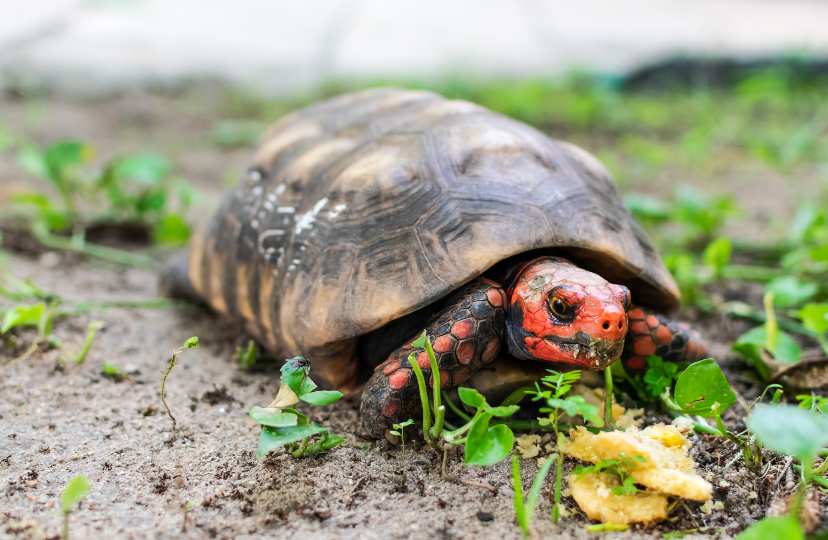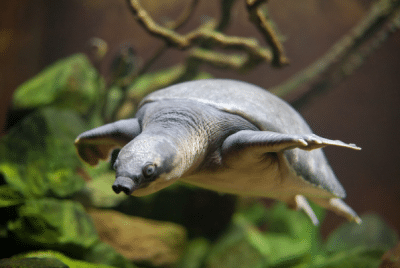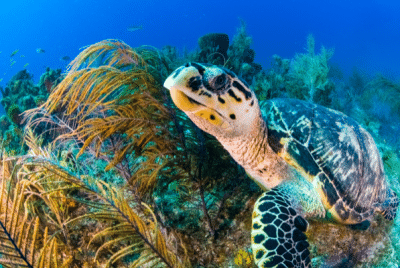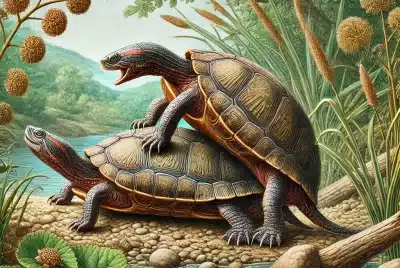Cherry Head Tortoise: the South American beauty
Introduction to Cherry Head Tortoise
Hi there fellow tortoise enthusiasts! Today, I’m beyond thrilled to discuss the Cherry Head Tortoise. Ever laid eyes on a creature so unique and charming that it almost seems unreal? Well, Cherry Head Tortoises give you precisely that feeling. They are magnificent creatures that steal the spotlight with their vibrant colors and captivating presence.

History of Cherry Head Tortoise
The Cherry Head Tortoise, also known as the Red-Footed Tortoise’s smaller cousin, has its roots in the lush, tropical forests of South America, especially in regions like Brazil and Paraguay. Its unique name, which has become an emblematic description, comes from the vivid red or orange scales that color their head. This striking feature isn’t merely aesthetic; it has evolved as an adaptive trait, serving as a camouflage mechanism within their vibrant natural habitat.
Over time, the Cherry Head Tortoise has become a beloved pet for many enthusiasts around the world. Its distinct appearance and fascinating background create a captivating allure that draws people to learn more about this wonderful species. Understanding the origins of the Cherry Head Tortoise isn’t just intriguing; it’s a vital part of preserving and caring for them in both their native environment and in homes around the globe.
Physical Characteristics
Appearance
The Cherry Head Tortoise is a marvel of nature, known for its distinct and appealing physical appearance. What sets this species apart is its vibrant, cherry-red head, living up to its name and giving it an unmistakable identity. This red coloring blends with the yellow and black patches on its carapace, creating a unique, captivating pattern.
Size and Dimension
An adult Cherry Head Tortoise typically measures between 10 to 12 inches in length, with males slightly larger than females. Its limbs are stout and strong, with scales that can vary in color, matching the brilliance of its head. The Cherry Head’s eyes also reflect its characteristic color, enhancing its overall charm. Its shell is moderately domed, providing both protection and aesthetics. The combination of these features makes the Cherry Head Tortoise not just an attractive creature but a fascinating subject of study and admiration among enthusiasts and professionals alike.
Habitat
The Cherry Head Tortoise thrives in the lush and humid environments of South America, particularly in regions such as Brazil, Paraguay, and Argentina. Its preferred habitat consists of tropical and subtropical forests, grasslands, and savannas, where the climate is warm and the landscape is rich in vegetation.
The moisture in these environments supports the growth of a diverse array of plants, which not only serve as a food source but also provide shelter and camouflage. The bright red head of the Cherry Head Tortoise, in fact, blends seamlessly with the vibrant flora of these regions.
The habitat also provides ample space for roaming, basking, and burrowing. This intricate connection between the Cherry Head Tortoise and its natural habitat emphasizes the importance of conservation efforts to preserve these beautiful landscapes, as they are essential for the well-being and survival of this remarkable species.
Diet
Preferred Foods
The Cherry Head Tortoise’s diet is an eclectic mix that requires understanding and attention to ensure their health and vitality. In the wild, these tortoises are omnivorous, feasting on a variety of leafy greens, fruits, flowers, and occasional animal proteins such as insects and worms.
A well-balanced diet for a captive Cherry Head Tortoise should mirror this natural intake. Providing fresh vegetables like kale, dandelion greens, and collard greens, complemented with fruits like apples and melons, can make a nourishing meal. Protein should be introduced sparingly, perhaps through insects or low-fat meat. Just as we humans need variety and nutrition in our meals, so do Cherry Head Tortoises. Think of crafting their meals as an art, where you blend the essential nutrients in a way that keeps your shelled friend healthy and satisfied.
Foods to Avoid
Just like us, Cherry Head Tortoises have foods that they should steer clear of to maintain optimal health. Feeding them a wrong diet can be likened to humans eating fast food daily – it’s simply not beneficial in the long run. Foods high in oxalic acid, such as spinach and rhubarb, should be avoided, as they can inhibit calcium absorption, leading to potential health issues.
Similarly, processed human foods, dairy products, and high-fat meats are not suitable for Cherry Head Tortoises. These items can cause digestive problems and nutritional imbalances. Foods like lettuce, although not harmful, provide little nutritional value and can lead to deficiencies if fed regularly. It’s essential to be cautious and knowledgeable about what goes into their diet. After all, wouldn’t you want your shelled friend to enjoy a meal that’s not only tasty but also nourishing and safe?
Care and Maintenance
Housing
Creating an ideal turtle tank habitat for a Cherry Head Tortoise is like designing a comfortable home that caters to its natural preferences. It starts with selecting a spacious enclosure that mimics their tropical habitat. The substrate should be a mixture of organic soil and sand, allowing them to burrow. Humidity is crucial, so incorporating a shallow water dish and regular misting helps maintain a moist environment. Adding live plants, logs, and rocks will not only beautify the space but also provide hiding spots and basking areas. Since Cherry Head Tortoises are sun-lovers, a basking lamp with UVA and UVB rays is essential for their health. The temperature should range from 75 to 85°F (24 to 30°C), with cooler nighttime drops. Regular cleaning and maintenance ensure a hygienic space. In essence, recreating their natural habitat is key to a happy and healthy Cherry Head Tortoise at home!
Common Health Issues
Like all living beings, Cherry Head Tortoises are susceptible to certain health issues, which can be likened to common ailments in humans. Respiratory infections are one of the more frequent problems, often characterized by nasal discharge and difficulty breathing. This can be due to improper humidity or temperature in their habitat. Metabolic bone disease, resulting from an improper diet lacking in calcium and vitamin D3, can lead to soft shells and skeletal deformities.
Parasites and internal infections may also pose a threat if cleanliness is neglected. Issues like shell rot and eye infections can manifest if the living conditions are damp and dirty. Overgrown beaks and nails are also common but can be prevented with regular care and check-ups. Understanding these issues is vital in caring for a Cherry Head Tortoise, as prevention and early intervention can make the journey of caring for your shelled friend smooth and rewarding.
Preventive Measures
Preventing health issues in Cherry Head Tortoises is akin to keeping ourselves healthy through proper diet and hygiene. Balanced nutrition, including the right mix of vitamins and minerals, prevents metabolic bone disease. Proper lighting with UVB rays ensures they absorb the essential vitamin D3, crucial for shell health. Maintaining the correct temperature and humidity levels in the enclosure can stave off respiratory infections. Regular cleaning and a properly set-up habitat deter parasites and conditions like shell rot.
Overgrown beaks and nails can be managed with appropriate surfaces for them to wear them down or regular professional grooming. Regular veterinary check-ups are paramount, acting as the equivalent of our routine doctor’s appointments. Prevention is always better than cure, and with careful observation and understanding, you can create a thriving environment for your Cherry Head Tortoise. After all, who doesn’t want their shelled companion to live a long, happy life?
Breeding
Breeding Cherry Head Tortoises is an endeavor filled with both excitement and responsibility. It’s like being a matchmaker and a caretaker, all rolled into one. First and foremost, ensuring that you have a healthy pair, with a male and a female, is critical. Age matters too; typically, they should be at least 5 years old to breed successfully. Providing a suitable nesting area within the enclosure filled with soft soil will encourage the female to lay eggs.
Temperature regulation is crucial, as it can influence the gender of the hatchlings. Maintaining it between 82 to 86°F (28 to 30°C) often results in a mix of male and female offspring. Monitoring the eggs’ humidity and temperature becomes a daily task. Patience is vital, as the incubation period ranges from 120 to 150 days. Breeding Cherry Head Tortoises is a rewarding experience but requires dedication, knowledge, and a gentle touch.
Conclusion
In the journey through the fascinating world of Cherry Head Tortoises, we’ve delved into the vibrant tapestry that makes up their existence. From their stunning cherry-red heads, which seem painted by Mother Nature’s own brush, to their unique behaviors and habitats, these creatures captivate and inspire. Understanding their origins, physical characteristics, preferred natural habitats, and ideal diets paints a picture not just of a pet but of a complex being that thrives on care and knowledge.
Creating the perfect habitat for them is akin to designing a dream home, with every detail tailored to their comfort and health. Addressing their common health issues and understanding preventive measures is a call to responsible stewardship, highlighting the parallels between their well-being and our own.
For those contemplating breeding, the Cherry Head’s lifecycle offers another layer of complexity and reward, providing a window into the marvels of nature. But beyond the technicalities and the do’s and don’ts lies something more profound.
The Cherry Head Tortoise teaches us about adaptability, survival, and the delicate balance of ecosystems. It stands as a symbol of nature’s diversity and beauty and serves as a reminder of our responsibility to protect and respect all forms of life.
Whether you’re an enthusiast, a potential pet owner, or someone simply intrigued by the wonders of the natural world, the Cherry Head Tortoise extends an invitation to explore, learn, and marvel. In caring for them, we not only enrich our lives but also contribute to preserving a species that adds color and life to our world. How could we resist such an invitation?
FAQs
- What’s the lifespan of a Cherry Head Tortoise? They typically live between 50 to 60 years.
- Can Cherry Head Tortoises live with other tortoises? With proper care and attention to their individual needs, cohabitation is possible.
- What’s the ideal temperature for their habitat? A range of 75 to 85°F (24 to 30°C) keeps them comfortable.
- Are Cherry Head Tortoises endangered? They are not classified as endangered, but habitat destruction poses threats.
- How often should I take my Cherry Head Tortoise to the vet? Regular check-ups are advised, at least once a year.







Comments are closed.